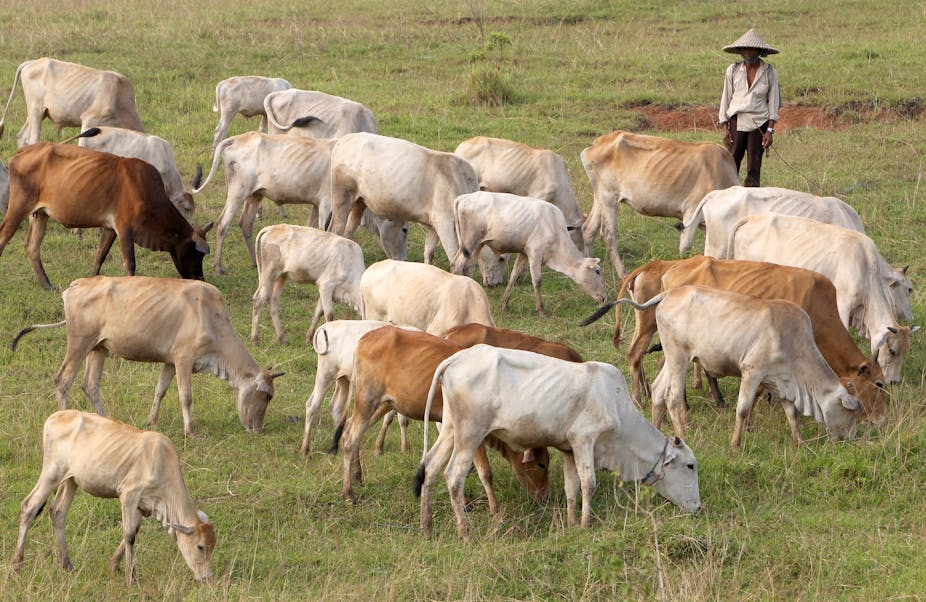When it comes to the live animal export industry, the government’s knee-jerk reactions leave it open to criticism that it dances to whichever group, industry or the animal activists, plays the loudest tune.
First we had the shocking revelations to the public (but not government) of how the animals were being slaughtered, followed quickly by the government export ban which left thousands of cattle stranded without food.
Then we had the increasing pressure from northern Australia’s cattle producers, culminating in the threats from one producer to shoot his cattle, which ended in a sudden lifting of the ban yesterday.
Admittedly the situation in Australia’s north is dire; this was no sabre-rattling by the cattle producers. The only saving grace is the higher than usual reserves of fodder in northern Australia after a period of La Niña weather.
But having put the Australian cattle producers, their animals and the Indonesian consumers through such hardship, surely the government could have extracted more welfare reform than an assurance that the welfare of the cattle can and apparently will now be monitored through to slaughter.
The industry will be monitored, but will it be changed? Probably not.
Cattle will still be ignominiously wrestled to the ground before slaughter, which may be by blunt knives taking up to 18 cuts to sever the poor animal’s head (as reported in the MLA/Livecorp review of Indonesian slaughter practices in 2010).
They will still stand watching their herdmates being butchered and they will still beat their heads repeatedly on the ground in desperation.
The promise of independent auditors to ensure that the standards of the OIE World Animal Health Organisation are upheld offers little comfort. If the Australian government officials couldn’t get access to the abattoirs to investigate standards for themselves, how can we be sure that an effective audit will be undertaken?
Who will conduct the audit? Indonesians might be excused for wanting to do it themselves in their own country but will Australians accept that? OIE officials would be the logical choice, but it is way beyond their resources.
The OIE only accepted the role of developing world animal welfare standards in 2002, and even that was stretching their international animal health role a bit far.
Welfare is much more than just good health, as the current debacle effectively demonstrates. These animals are fit and well when presented for slaughter, their health is not an issue, but they are still subjected to a welfare challenge that is feared by humans and animals alike – a slow and painful death.
What does slaughter to OIE standards mean? The manner in which they were written suggests that virtually nothing is enforceable under Australian jurisdiction, even ignoring the fact that they are not in Australian territory.
The standards are centred around exhortations that people “should”, rather than “must”, treat animals in a certain manner, which Australian legislators interpret as meaning that it ought to be done, but is not mandatory.
Then there are the numerous vague statements that could never be enforced, let alone scientifically justified. For example, stocking density should be “optimum” for climatic conditions.
Another example: “Animals should be grasped or lifted in a manner which avoids … suffering” ignores the fact that all livestock suffer a stress reaction when they are approached by humans, let alone being grasped or lifted.
And what about, “Excessive shouting at animals or making loud noises to make them move should not occur”? The picture is ludicrous. “Excuse me, would you repeat that so I can capture it on my decibel meter?”
I give these examples, at the risk of appearing facetious, because the OIE standards are clearly not scientifically-derived, defendable or appropriate for the purpose for which they are being proposed.
By contrast, the Australian animal welfare standards have progressed over time so that they comprise enforceable limits on all of the contentious aspects of the slaughter process, including stunning.
To be fair, the OIE standards are not totally without worth when it comes to slaughtering Australian cattle in Indonesia.
They do outlaw the breaking of animals’ legs and tendons to immobilise them before slaughter. But they were written to improve the slaughtering practices for people in developing countries killing their own animals.
The Australian public demands that our animals are treated better than this.
Not surprisingly, the Indonesian government has been offended by the Australian government’s actions and has threatened to source much of its beef from elsewhere.
This could work to Australia’s advantage in the long run. It was just too easy to put cattle on a boat to Indonesia, giving the Indonesians the responsibility of managing the crucial last few weeks of their short lives.
Of course their welfare standards are lower than ours, their slaughtermen are from the low socioeconomic classes and struggle to make a living for their families.
Low cost of the slaughter operation and protecting the family’s breadwinner from a dangerous animal are the two main priorities, not the animal’s welfare.
Wouldn’t we do the same if we were in that situation? Australians have the capability, and now the necessity, to develop a vacuum-packed meat trade that can supply high quality beef to countries around the world.

